|
|
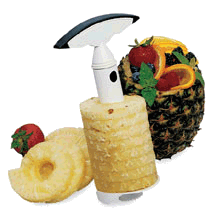 From the local grocery store, choose a mature pineapple that has
healthy, firm, green leaves (not yellow or brown) and with a fruit skin that is
golden brown (not too green). Actually, I'd recommend growing two pineapples in
the not unlikely event that one of them dies. At the very least you can pick the
healthiest of the two plants to nurture to full growth. Also, if you find you
have more pineapple than you can eat, just chop it up and freeze it. It tastes
great!
Inspect the base of the leaves for small grayish spots which are scale
insects. If these are found, the crown should be discarded and one selected
which is free of these insects. Try to find one that is ripe but not overripe.
Test for ripeness by gently pulling on a leaf. If it pops out with ease, the
fruit is overripe. From the local grocery store, choose a mature pineapple that has
healthy, firm, green leaves (not yellow or brown) and with a fruit skin that is
golden brown (not too green). Actually, I'd recommend growing two pineapples in
the not unlikely event that one of them dies. At the very least you can pick the
healthiest of the two plants to nurture to full growth. Also, if you find you
have more pineapple than you can eat, just chop it up and freeze it. It tastes
great!
Inspect the base of the leaves for small grayish spots which are scale
insects. If these are found, the crown should be discarded and one selected
which is free of these insects. Try to find one that is ripe but not overripe.
Test for ripeness by gently pulling on a leaf. If it pops out with ease, the
fruit is overripe.To make the most use of the pineapple, use the pineapple corer you see here. It's an inexpensive but ingenious little gadget that cores and slices all in one step. To see it work, click here. To order one, and support this web site, click here or click on the picture above. They also make great gifts! |
|
STEP TWO - Prepare the Crown
|
Grab hold of the entire top
set of leaves. Twist hard and it will come out with a bit of stalk. (If you cut
the top off you will need to remove all of the excess fruit flesh, otherwise it
will only rot and may kill the whole plant). Any adhering flesh should be
trimmed off its base to prevent rotting after planting. After trimming, carefully slice small, horizontal sections from
the bottom of the crown until you see root buds that appear as small dots or
circles on the flat, cut surface (see picture). Remove as little tissue as
possible to avoid cutting into young stem tissue.
Next, strip off some of the lower leaves, exposing up to about an inch of the
base After trimming, carefully slice small, horizontal sections from
the bottom of the crown until you see root buds that appear as small dots or
circles on the flat, cut surface (see picture). Remove as little tissue as
possible to avoid cutting into young stem tissue.
Next, strip off some of the lower leaves, exposing up to about an inch of the
base of the crown (the stalk will root but the leaves will rot - see photo). They
will come off in sort of a spiral fashion. The idea is to bare the stalk. The
small brown-colored bumps below the leaf scars are root primordia (baby roots
waiting to grow) and there may even be a few short roots at the base of the
crown (the picture at right shows a crown with a lot of roots). Though
these won't be the roots that will grow in the next step, try not to damage
these.
of the crown (the stalk will root but the leaves will rot - see photo). They
will come off in sort of a spiral fashion. The idea is to bare the stalk. The
small brown-colored bumps below the leaf scars are root primordia (baby roots
waiting to grow) and there may even be a few short roots at the base of the
crown (the picture at right shows a crown with a lot of roots). Though
these won't be the roots that will grow in the next step, try not to damage
these. After trimming and stripping, let the crown dry out for a couple days before going to the next step. This will permit the cut end and the leaf scars to heal and prevent rot. |
|
Flowering and Fruiting
|
Although the pineapple plant
is attractive in and of itself, most growers want their plants to flower and
fruit. In Hawaii, a crown takes about twenty to twenty-six months to produce a
ripe fruit. However, it may only take twenty months, and you will see some
surprises along the way. When your plant is at least 24 inches tall and twelve
to fourteen months old, an inflorescence bud will begin to form in the center of
the leaves. You will not be able to see the developing fruit until about two
months later when it will surprise you with a bright red cone emerges from its
center. For an excellent photo log (Plog?) of one enthusiast's success with
growing a fruit, click here.
(By the way, to the right you can see very healthy baby pineapples growing at
Longwood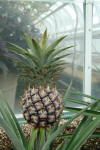  Gardens, in Longwood, PA. There were a total of 8 plants in the room. Clearly
they have a system that works!)
Gardens, in Longwood, PA. There were a total of 8 plants in the room. Clearly
they have a system that works!)After twenty months come the flowers. Bright blue flowers open row by row, starting at the bottom, over about two weeks (flower development in Hawaii typically occurs in late December or January when the days are short (about 10.5 hours) and the nights are cool (55 to 65 F; about 13 to 18 C)). Each flower only lasts one day, but there are many to enjoy. When the petals of the last flower have dried, the fruit begins to develop. After three to six months from this period, your fruit will begin to ripen. When the fruit is golden halfway up, your pineapple is ready. Surprisingly enough it will be just about the size of a can of pineapple, or a bit larger. If your pineapple plant is at least 24 inches tall and has not flowered by the time it is twenty to twenty-four months old, you can "force" it with a few different techniques that trick the plant into putting its energy into flowering instead of making new leaves. |
| Forced
Fruiting It is best to force the plant to flower during the winter months when the days are cooler and shorter as this is when a pineapple is accustomed to making fruit. The first technique is to lay the plant and pot on its side between waterings. This interferes with hormones in the plant, causing the production of another hormone, ethylene, which induces flowering. A second method of inducing flowering is to place the plant in a bag with two ripe & bruised apples for two weeks. Move the plant to a shady location during this time, and then move it back to its sunny spot. The ripening apples produce ethylene gas that will induce flowering in the pineapple. A third method is to place a small lump of calcium carbide about the size of your little fingernail in the center of your plant and pour a quarter cup of water over it. This will release acetylene gas that will force your plant to flower. To improve your chances of success, it is best to treat your plant in the evening after the sun goes down and temperatures are cooler. (Calcium carbide may be obtainable at a welding shop, garden store, pharmacy or toy store.) Two to three months later, the plant should form a flower spike in its center. |
| Harvesting your
pineapple When your fruit is about six months old, about four months after flowering 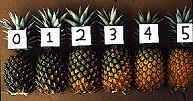 has occurred,
changes begin to occur. The color of the shell changes from green to rich gold.
The color change of the shell occurs first at the bottom of the fruit and moves
upwards.
During this change, the fruit becomes sweeter and the color of the flesh
changes from white to yellow. The fruit will weigh from two to four pounds. When
the fruit is golden half way up it can be picked and eaten, though if you wait
until it's fully ripe it will be worth the wait! Once the fruit develops, it
should last on the plant for several
months. has occurred,
changes begin to occur. The color of the shell changes from green to rich gold.
The color change of the shell occurs first at the bottom of the fruit and moves
upwards.
During this change, the fruit becomes sweeter and the color of the flesh
changes from white to yellow. The fruit will weigh from two to four pounds. When
the fruit is golden half way up it can be picked and eaten, though if you wait
until it's fully ripe it will be worth the wait! Once the fruit develops, it
should last on the plant for several
months. |
|
What Next?
|
Over the previous year, there
may have been a few new plants to emerge from the lower foliage. Let these grow
as large as possible before you remove them to start the process all over again
using the same method as with the original mother plant. In addition, there may
be one or more shoots, suckers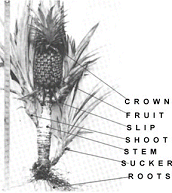 or slips (see
picture) that you may have noticed after harvesting the fruit that are growing
from the mother-plant stem. Slips and shoots grow most rapidly while attached to
the mother plant, so it is best to let them grow for several months after the
fruit is removed. After these branches are about 12 inches long, you can cut or
break them off close to the stem and grow your slips, suckers and shoots in the
same manner you did your crown. In the case of slips, there may be a small knob
at their base. This should be cut off. Because they are larger, slips and shoots
will produce a fruit in less time than to takes for a crown.
If you want your original plant to produce another fruit, leave one or at
most two of the shoots on the plant to produce a second, or ratoon, fruit.
Excess shoots can be cut off and potted. Continue to feed and water your plant
as you did when it was first planted. In Hawaii, it takes about one additional
year to produce a first ratoon fruit. If the plant remains healthy, it may even
be possible to produce a third crop, called a second ratoon. You can also grow
another plant from the crown of the harvested fruit, leaving you with several,
new, free plants. or slips (see
picture) that you may have noticed after harvesting the fruit that are growing
from the mother-plant stem. Slips and shoots grow most rapidly while attached to
the mother plant, so it is best to let them grow for several months after the
fruit is removed. After these branches are about 12 inches long, you can cut or
break them off close to the stem and grow your slips, suckers and shoots in the
same manner you did your crown. In the case of slips, there may be a small knob
at their base. This should be cut off. Because they are larger, slips and shoots
will produce a fruit in less time than to takes for a crown.
If you want your original plant to produce another fruit, leave one or at
most two of the shoots on the plant to produce a second, or ratoon, fruit.
Excess shoots can be cut off and potted. Continue to feed and water your plant
as you did when it was first planted. In Hawaii, it takes about one additional
year to produce a first ratoon fruit. If the plant remains healthy, it may even
be possible to produce a third crop, called a second ratoon. You can also grow
another plant from the crown of the harvested fruit, leaving you with several,
new, free plants. |








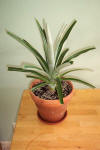

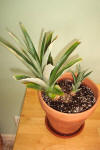

cty4547hhjuy
ReplyDeletegolden goose outlet
golden goose outlet
golden goose outlet
golden goose outlet
golden goose outlet
golden goose outlet
golden goose outlet
golden goose outlet
supreme outlet
golden goose outlet